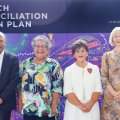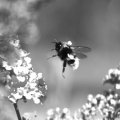University of Queensland Earth Sciences Department head Professor Ken Collerson will travel to Antarctica on the RSV Aurora Australis early next year to conduct research into the geological history of the icy continent.
During the first three months of 1997, Professor Collerson will map the geology of an isolated volcano which erupted beneath the ice cap 50,000 years ago.
It will be Professor Collerson's second trip to Gaussberg, located on the edge of the continent between the Antarctic stations of Mirny and Davis at 67 degrees south, 89 degrees east. Even though the volcano was discovered by a German expedition 95 years ago, the $351,700 study represents the first integrated field, geochemical, isotopic and geochronological study of Gaussberg.
According to Professor Collerson, the fact that the Gaussberg has a similar composition to rocks which contain diamond in the Kimberley region of Western Australia is of particular academic interest.
'As the volcano's lavas contain small fragments of the mantle and crust that were incorporated during eruption, the study will provide valuable information regarding mantle composition and the geological history of the continental crust beneath the ice cap in this part of Antarctica,' Professor Collerson said.
To study and sample the volcano, Professor Collerson will spend four weeks camping in the isolated area with PhD student Robyn Frankland and a field training officer from the Federal Government's Australian Antarctic Division, part of the Department of Environment, Sport and Territories.
To reach the area, Professor Collerson will travel by icebreaker to the edge of the pack ice of the Western Ice Shelf 100km from the volcano then be flown to the site by long-range helicopter.
After completing the Gaussberg fieldwork, his field party will be transferred 600km by helicopter to Davis Station where they will meet the Aurora Australis for the return voyage to Australia.
'During my return voyage, I will spend a little time on Heard Island collecting lava from Big Ben, Australia's only active volcano. Subsequent chemical and isotopic analysis of these basalt samples which erupted during the 1990s will provide knowledge of melting processes which produced the volcano as well as the time scales of magma transport from mantle source to eruption,' Professor Collerson said.
'All samples will be analysed at the Department's Radiogenic Isotope Laboratory on my return as no other Australian laboratory has this analytical capability,' he said.
Completed in December 1994, the ultra-clean chemistry and mass spectrometer facility cost more than $4 million to build and equip and is one of only a handful of laboratories in the world with the level of analytical sophistication and quality of equipment capable of analysing the Antarctic samples.
The clean laboratories provide an environment for the generation of high precision radiogenic isotope ratio data as well as ultra-low-level trace element analytical information. These data are used for research in the areas of earth science, environmental studies, toxicology, medical and forensic research.
For more information, contact Professor Collerson (telephone 07 3365 1180).



